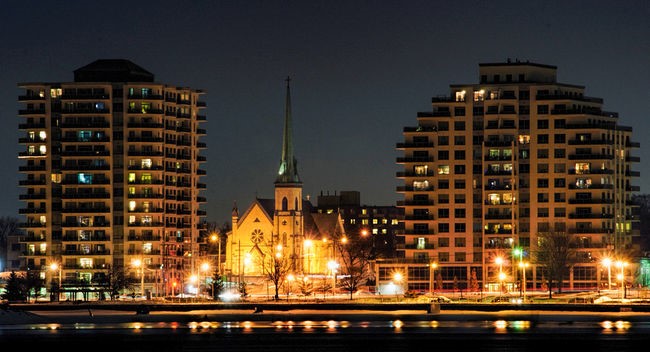By Tyler Kula for the Sarnia Observer
(2009) Repair work on Our Lady of Mercy Church has been delayed and should take until October to complete.
Project manager Henry Forget of Roof Tile Management said repairs on the 130-year-old Christina Street structure, initially expected to take four months, were extended when workers discovered the paneling was not secure along the building’s steeple.
“We weren’t originally planning to scaffold all the way up to this point, to the top of the steeple,” Forget said, standing calmly and leaning against the guardrails roughly 175 feet above Sarnia’s waterfront.
“We noticed, as we got to the top, the panels were quite loose, starting to have that negative pressure, pulling the panels off of the building,” he said.
To fix it, they attached copper bars running from top to bottom along the copper roof to hold the panels – fastened at the bottom but not along the top – in place.
The fix should last for 50 years, Forget said, at least as long as the copper that’s already on the steeple.
Additional costs from the roof pushed the price tag up from $1 million by about $10,000. Projected final cost of the project is $1.1 million.
Most of the scaffolding around the steeple is coming down within one week, Forget said, but there’s a lot of work left to do.
“We’ve mostly done a lot of metal fabrication,” he said. “With the old wooden components on the building, we’ve changed them all to a non-maintenance, metal fabricated unit.”
All decorations are now made out of lead coated copper as opposed to painted wood, the masonry has been restored by Bartlett Restoration, window frames have been redone, repainted and have been given protective glazing to prevent air movement between panes of glass.
The building has 37 stained glass windows, perhaps the most impressive of which is “the rose window,” which faces the St. Clair River.
Up to 15 workers are on site any given day, Forget said, adding the work is particularly satisfying because of its unique nature.
“We do a lot of work for the Catholic diocese,” he said. “They have a lot of detail in the work so for us it’s nice because we can do the proper practices and not try to have to do any cookie cutter work that you see in a lot of residential construction.”
The cross on top of the steeple has been re-enforced and a second metal cross is under construction to replace a wooden one on the building’s lower roof.
Gutter systems are being made stronger after workers had to replace rot on a lot of the eaves.
A new lightning protection system was installed, grounding everything, including the circa 1864 bell.
“We’ve replaced the lightning protection system only because it wasn’t quite up to the standards we have today,” Forget said.


